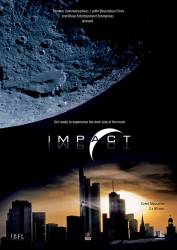Factual error: The Moon is pushed into a "more elliptical" orbit. When the orbit it shown, it is more eccentric than the Moon's real orbit. However, it is centered directly on the Earth. This violates Kepler's first law of motion, which states that a natural satellite has the primary body at one focus of an elliptical orbit. In other words, the Moon should come much closer to the Earth at one end of the ellipse, and recede very far from it at the other end, rather than receding to the same distance in both directions.
Factual error: The Moon is struck by a "brown dwarf fragment" having twice the mass of the Earth, which isn't noticed by anyone on Earth until a few minutes before impact. But an object of this mass would have profound effects on Earth's tides; its effects would have been equal to those of the Moon from the time that the object was within 2 million km of the Earth, over five times the Earth-Moon distance. (At astronomical speeds, this would provide nearly a full day's warning.) Such anomalies would not have gone unreported; they would be of universal interest to the scientific community. And because the planet's tides are highly predictable and heavily monitored, anomalies worthy of scientific examination would have occurred when the object was further still.
Factual error: Almost immediately after the brown dwarf fragment embeds itself in the Moon, the Moon moves 30 million km closer to the Earth. The brown dwarf fragment is said to have twice the mass of Earth. The result is that tidal forces due to the Earth-Moon interaction would be 200 times greater than our real tidal forces. This would cause widespread flooding as massive tidal surges affected coastal areas, an effect not seen in the film.
Factual error: A graduate student states that a frog was levitated by using a magnetic field to "manipulate gravity," and a college professor, presented as an expert on the topic, agrees. It's true that a frog was levitated via a magnetic field, but the field was used to produce a diamagnetic force on the frog greater than the force of gravity. Gravity itself was not affected in any way. A layperson could make this mistake, but not anyone with a basic understanding of electromagnetism.
Factual error: It is stated that, due to the Moon's increased mass, the astronauts will weigh twice as much there as they do on the Earth. The Moon's new mass is twice that of the Earth, but the Moon's diameter remains one-fourth that of the Earth. Since gravity varies inversely with the square of distance, the astronauts would actually weigh closer to 32 times their Earth weights, which would likely be prohibitive for the mission.
Factual error: When Dr. Emerson finds a meteorite, which he says he believes is a "a fragment from a brown dwarf", Alex explains to his student that a brown dwarf is a remnant of a dead star, consisting of a very densely packed matter. However, brown dwarfs, as real-world astrophysicists know them, are sub-stellar objects which are too small to sustain hydrogen fusion ("failed stars", too massive to be a planet but too small to become stars). What Dr. Kittner talks about is perhaps a white dwarf. (00:40:00)
Factual error: When the brown dwarf fragment embeds itself in the Moon, the Moon continues to orbit the Earth. But the brown dwarf fragment is twice as massive as the Earth, so the Moon and Earth now have comparable masses, instead of the Moon having about 1/80 of the Earth's mass, as it really does. In this case, both the Earth and Moon would be visibly orbiting a common center of gravity that would be outside of both bodies, but closer to the Moon. Even now, the Earth and Moon orbit this common center of gravity; it just happens to be inside of the Earth (though not at its center).
Factual error: The Moon is struck by a brown dwarf fragment having twice the mass of the Earth but a diameter of only 19 km. The initial effects to the Moon are akin to what would be expected of an impact from a 19-km body made from terrestrial material: formation of a large crater, release of ejecta, and seemingly minor disruption of the Moon's orbit. However, it is primarily the mass, not the size of the impactor, that determines the effect. Since the body had twice the mass of the Earth, it would have smashed the Moon into smithereens. Conversely, a 19-km asteroid made from cotton candy would have done very little damage.





